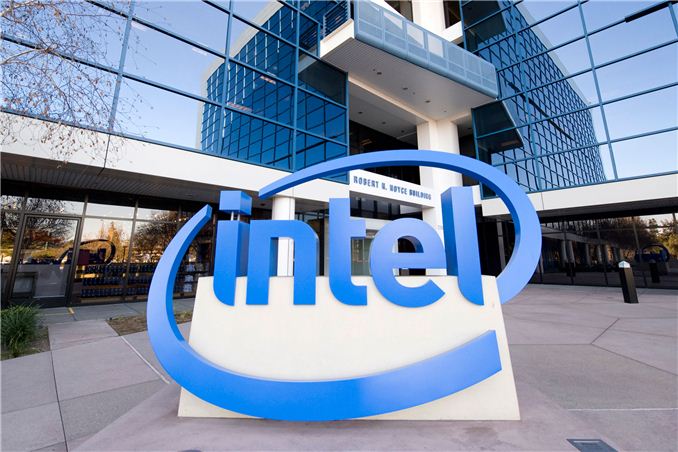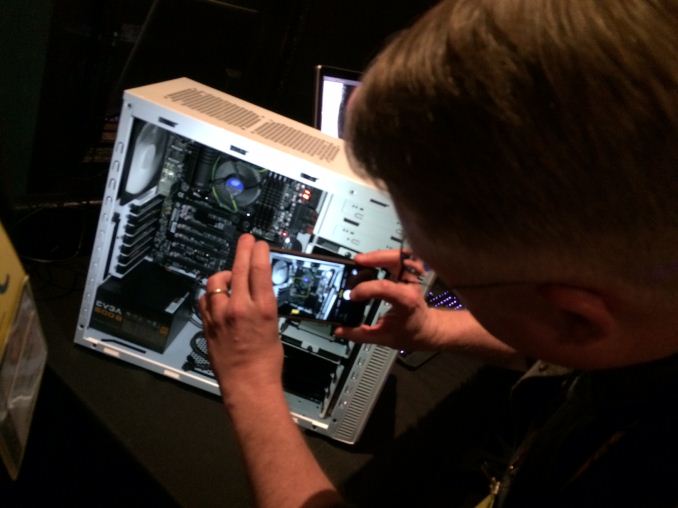Unlocked Socketed 65W Broadwell Iris Pro Desktop CPU Demoed by Intel at GDC15
by Ian Cutress on March 5, 2015 1:22 PM EST- Posted in
- CPUs
- Trade Shows
- Overclocking
- Broadwell
- Crystal Well
- Iris Pro
- Unlocked
- 65W
- 14nm
- GDC15

The next twelve months are set to be exciting times for the desktop space for Intel. While the current fifth generation mobile processors are coming to market, and the sixth generation being talked about in hushed tones, Intel demonstrated a PC that was listed as having a Broadwell desktop part (Broadwell-DT). The interesting culmination of factors surrounding this part is that it was listed as being socketed, unlocked and containing Iris Pro internal graphics.
The key elements here include the CPU being socketed (replaceable), unlocked (overclockable) and having Iris Pro, or Intel’s extended eDRAM segmentation usually under the Crystal Well name but with the much improved Generation 8 graphics architecture. While we have heard that an unlocked Iris Pro has been coming to desktop since March last year, very few details were given at the time, and the news today at least puts a TDP on such a part: 65W. Normally the high end SKUs from Intel are 77W to 85W, suggesting that this component may not in actual fact be an i7, or it could be an Iris Pro part but using one of the low power monikers such as ‘S’.
Image from Intel
The news also puts on a more firm date, so rather than ‘2015’ we get ‘mid-2015’, which puts it within the May to September timeframe. There are two important events occurring between those dates - Computex in June and the Intel Developer Forum in August, suggesting that Intel may aim for one of these events to have a formal launch.
Despite the launch of 14nm on the desktop, there has been recent talk of Intel’s next architecture, Skylake, also occurring within the year. This puts Intel in an interesting dynamic of releasing two different platforms for desktop within the same year. One could speculate and suggest that these will synergistically work in tandem, with Skylake-DT taking a segment and Broadwell-DT taking another segment. Where mobile fits into all this as well is difficult to tell, especially given the launch of Broadwell-U and Core-M within the past few months.
As much as we would like more information, it seems that the only thing we can tell is that the motherboard being used looks like an EVGA design due to the right angled power connector. Intel is also stating that the Iris Pro model will be great for all-in-ones (no argument there) which could also feature its RealSense camera, enhancing compute power and interactivity. It would be interesting if a socketed Iris Pro was truly aimed at the AIO market, but then such a SKU would not need to be unlocked. Unlocking for the purposes of overclocking is naturally aimed at the desktop market, although usually for gamers with discrete GPUs rather than Iris Pro.
Naturally we want to get our hands on a sample for review. Ryan is at GDC this week so if he gets a chance to spend a few minutes with the system it would be interesting to hear what they actually represented in the demo as well as more information about the system itself.











78 Comments
View All Comments
Refuge - Thursday, March 5, 2015 - link
I'm pretty sure the days of Overclocking are coming to an end slowly.Eventually there won't be anything meaningful more to have than stock/boost clocks.
Ammaross - Friday, March 6, 2015 - link
Overclocking will always have a purpose. We could look at a 3.3GHz Intel chip and think "that's good enough," but when you can overclock it to 4.4GHz, you're getting a very tangible benefit (20% reduced render times, etc). Now in your future days of "not worth it" overclocking, where you're trying to bump 4GHz to 4.4GHz, the gains will be minimal, yes, but they're gains none-the-less, and could shave 10min off a 1hr render. That's still tangible.Notmyusualid - Friday, March 6, 2015 - link
Indeed overclocking will always have a place.I just noted with a smirk, that my 3920XM (a mobile chip) performed higher than that MSI GT80 Titan beast of a rig (just released), in Intel's CPU benchmark. Informing me, that after almost 3yrs later (system shipped in July 2012, just checked Dell website) my everyday computer experience is likely to be quicker than that thing. I'm aware the 4940XM exists, but due to electrical incompatability, I'm not able to use it, sadly.
Surly Intel must know some of us would buy NEWER chips, even in the Desktop Replacement catagory, were they actualy made available.
Small rant - not all of us will replace our systems as often as Intel would like, and with no QHD 18.4" *socketable CPU* (important that one) laptops out there, I may be holding onto this one for some time to come.
Refuge - Monday, March 9, 2015 - link
I disagree, and it doesn't matter if I do since everything here is simply us predicting the future.But I feel that overclocking will go the way of the Dodo in say... 4 - 6 years?
Eventually it just won't be worth it, the gains will be too small. Because I believe in 4-6 years you will be lucky to get even 5% with an OC board and unlocked chip.
Right now? Yes, it is worth it, even if it isn't nearly as fun as it used to be. I miss comparing clocks with my friends back in Sandybridge days, those were fun days... :)
MyCookie - Thursday, March 5, 2015 - link
Crystal Well also had a 65W TDP for 'desktop' parts. I find it likely that they will launch Broadwell unlocked CPUs with Iris Pro and Skylake unlocked CPUs with HD graphics.BlueBlazer - Thursday, March 5, 2015 - link
New 3DMark API Overhead Test - Running on Intel 5th Gen Core Processor https://www.youtube.com/watch?v=rFhu4lpRAKw using DirectX 12. Could that be Broadwell's Iris Pro?TallestJon96 - Thursday, March 5, 2015 - link
As someone looking to upgrade to a new build from a gen2 i3 desktop, this is interesting. It's possible that by the end of the year we will have 14nm Skylake, instead of good ol' haswell. I'd love to build an i5 Skylake Desktop, but I have to wonder if there will be any real gains, especially as I will be running dedicated graphics.Really, these changes are intended for mobile, and the improved performance and battery life are much appreciated.
Novacius - Thursday, March 5, 2015 - link
Recently benchmarks have shown up, reporting a 15% IPC gain for Skylake in comparison with Broadwell. That means that Skylake should have a ~20% higher IPC than Haswell and at least 40% more than Sandy Bridge (depending on the application of course, because there is no such thing as "one IPC"). Add slightly higher frequencies and better energy effiency and you have a decent upgrade.Nagorak - Friday, March 6, 2015 - link
Yeah, but for all we know we'll end up with lower frequencies. I'm not saying we absolutely will, but the last few years Intel sure hasn't been pushing increased performance.The other issue is, all these integrated graphics chips are a complete waste for gamers, and gamers are one of the few groups who actually need higher performance. For your average user Haswell is already well beyond "good enough".
Xenonite - Friday, March 6, 2015 - link
I also think that the maximum boost frequencies will start comming down together with the maximum TDP (read: performance), even on the desktop. There is simply much more money to be made by limiting device refresh rates to 10-20 fps, reducing performance accordingly, and selling a 24hour or a 48hour battery life to the average consumer.Even for applications that get power from the wall, the allure of a sub 1mm thick desktop (possible with system TDPs on the order of 100's of miliwatts), somehow, generates much more sales than high-performance gaming ever could.
Together with the ever increasing R&D and manufacturing costs associated with high-frequency semiconductors, I dont see how any company will be able to convince its investors to build another record-breaking performance CPU in our lifetimes.